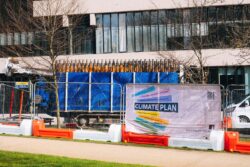Seismic characterisation and monitoring of urban geothermal reservoirs
Project Lead: Dr Adam Booth
Academic co-supervisors: Dr Sjoerd de Ridder
Project Summary and Outcomes
Heating accounts for around half of global energy demand, with 75% of that supplied by fossil fuels. In the UK, heating buildings is responsible for ~20% of carbon emissions. Decarbonising the supply of electricity has been relatively straightforward since the interventions required have not impinged significantly on people’s day-to-day lives. By contrast, decarbonising heating requires retrofitting of systems in every UK building therefore innovative solutions need to be found. Geothermal energy is attractive to this end: many urban centres overlie potential geothermal reservoirs, offering storage and extraction options for excess heat and providing significant reductions in carbon demand. Nevertheless, the UK lags behind other countries in exploring geothermal energy, owing in part to stakeholder concerns about the sustainability and economics of geothermal heating, and a lack of knowledge about the complexities of geothermal reservoirs (Figure 1).
Geothermal prospects therefore requires extensive characterisation prior to development, and monitoring during usage to ensure sustainable management. Here, geophysical methods can be particularly powerful and in this project, you will explore the application of seismic methods to characterising geothermal reservoirs.
The specific direction of your MRes research can be tailored to your existing expertise and ambitions, and could include (e.g.) ambient noise tomography, full waveform inversion, distributed acoustic sensing (DAS) or seismic interferometry. Research connections at the University of Leeds enable you to apply your developing expertise at a range of experimental geothermal sites. Of particular interest will be the University of Leeds’ own Geothermal Campus, a research facility established to explore the decarbonisation of university heating/cooling systems (Figure 2 and 3): a baseline DAS dataset exists for this site, which you could build upon with further surveys using our FEBUS Optics equipment. The supervision team is also part of the UK government-funded SmartRes project, exploring barriers to the uptake of urban geothermal systems. Through this, you can access newly-acquired archive DAS data from the British Geological Survey’s UKGEOS Cheshire observatory, and nodal seismic data recorded during active thermal testing.
During your time at Leeds, you will be part of the vibrant Institute of Applied Geoscience (IAG) in Leeds’ School of Earth and Environment, and a member of the Geosolutions Centre. In addition to surveying equipment, you will be able to access a range of powerful analytical tools including Shearwater Geoservices Reveal software, for handling seismic data.
The project will sit within the School of Earth and Environment.
About you
For your own background, you should be experienced in geophysics or a related quantitative discipline (e.g., physics, mathematics, computing). You should have a passion for translating theory into practical applications, with industrial and societal relevance. You will be guided in bringing your own ideas to your data analysis. We welcome applications from anyone with relevant academic or industrial experience.

